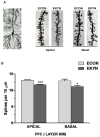Elevated levels of kynurenic acid during gestation produce neurochemical, morphological, and cognitive deficits in adulthood: implications for schizophrenia
- PMID: 25446576
- PMCID: PMC4731221
- DOI: 10.1016/j.neuropharm.2014.10.017
Elevated levels of kynurenic acid during gestation produce neurochemical, morphological, and cognitive deficits in adulthood: implications for schizophrenia
Abstract
The levels of kynurenic acid (KYNA), an endogenous negative modulator of alpha7 nicotinic acetylcholine receptors (α7nAChRs), are elevated in the brains of patients with schizophrenia (SZ). We reported that increases of brain KYNA in rats, through dietary exposure to its precursor kynurenine from embryonic day (ED)15 to postnatal day (PD) 21, result in neurochemical and cognitive deficits in adulthood. The present experiments focused on the effects of prenatal exposure to elevated kynurenine on measures of prefrontal excitability known to be impaired in SZ. Pregnant dams were fed a mash containing kynurenine (100 mg/day; progeny = EKYNs) from ED15 until ED22. Controls were fed an unadulterated mash (progeny = ECONs). The dietary loading procedure elevated maternal and fetal plasma kynurenine (2223% and 693% above controls, respectively) and increased fetal KYNA (forebrain; 500% above controls) on ED21. Elevations in forebrain KYNA disappeared after termination of the loading (PD2), but KYNA levels in the prefrontal cortex (PFC) were unexpectedly increased again when measured in adults (PD56-80; 75% above controls). We also observed changes in several markers of prefrontal excitability, including expression of the α7nAChR (22% and 17% reductions at PD2 and PD56-80), expression of mGluR2 (31% and 24% reductions at ED21 and PD56-80), dendritic spine density (11-14% decrease at PD56-80), subsensitive mesolimbic stimulation of glutamate release in PFC, and reversal/extra-dimensional shift deficits in the prefrontally-mediated set-shifting task. These results highlight the deleterious impact of elevated KYNA levels during sensitive periods of early development, which model the pathophysiological and cognitive deficits seen in SZ.
Keywords: Alpha7 nicotinic receptors; Glutamate; Kynurenic acid; Prefrontal cortex; Schizophrenia; Set-shifting.
Copyright © 2014 Elsevier Ltd. All rights reserved.
Figures






Similar articles
-
Early developmental elevations of brain kynurenic acid impair cognitive flexibility in adults: reversal with galantamine.Neuroscience. 2013 May 15;238:19-28. doi: 10.1016/j.neuroscience.2013.01.063. Epub 2013 Feb 6. Neuroscience. 2013. PMID: 23395862 Free PMC article.
-
Prenatal kynurenine exposure in rats: age-dependent changes in NMDA receptor expression and conditioned fear responding.Psychopharmacology (Berl). 2016 Oct;233(21-22):3725-3735. doi: 10.1007/s00213-016-4404-9. Epub 2016 Aug 16. Psychopharmacology (Berl). 2016. PMID: 27527585 Free PMC article.
-
Acute elevations of brain kynurenic acid impair cognitive flexibility: normalization by the alpha7 positive modulator galantamine.Psychopharmacology (Berl). 2012 Apr;220(3):627-37. doi: 10.1007/s00213-011-2539-2. Epub 2011 Oct 26. Psychopharmacology (Berl). 2012. PMID: 22038535 Free PMC article.
-
Kynurenic acid as an antagonist of α7 nicotinic acetylcholine receptors in the brain: facts and challenges.Biochem Pharmacol. 2013 Apr 15;85(8):1027-32. doi: 10.1016/j.bcp.2012.12.014. Epub 2012 Dec 25. Biochem Pharmacol. 2013. PMID: 23270993 Free PMC article. Review.
-
Cortical kynurenine pathway metabolism: a novel target for cognitive enhancement in Schizophrenia.Schizophr Bull. 2010 Mar;36(2):211-8. doi: 10.1093/schbul/sbq002. Epub 2010 Feb 10. Schizophr Bull. 2010. PMID: 20147364 Free PMC article. Review.
Cited by
-
Memory Enhancement with Kynurenic Acid and Its Mechanisms in Neurotransmission.Biomedicines. 2022 Apr 5;10(4):849. doi: 10.3390/biomedicines10040849. Biomedicines. 2022. PMID: 35453599 Free PMC article.
-
Acute sleep deprivation during pregnancy in rats: Rapid elevation of placental and fetal inflammation and kynurenic acid.Neurobiol Stress. 2019 Dec 14;12:100204. doi: 10.1016/j.ynstr.2019.100204. eCollection 2020 May. Neurobiol Stress. 2019. PMID: 32258253 Free PMC article.
-
Prolonged Subdural Infusion of Kynurenic Acid Is Associated with Dose-Dependent Myelin Damage in the Rat Spinal Cord.PLoS One. 2015 Nov 12;10(11):e0142598. doi: 10.1371/journal.pone.0142598. eCollection 2015. PLoS One. 2015. PMID: 26562835 Free PMC article.
-
Elevated kynurenine pathway metabolism during neurodevelopment: Implications for brain and behavior.Neuropharmacology. 2017 Jan;112(Pt B):275-285. doi: 10.1016/j.neuropharm.2016.03.001. Epub 2016 Mar 2. Neuropharmacology. 2017. PMID: 26944732 Free PMC article. Review.
-
Associations Among Obesity, Inflammation, and Tryptophan Catabolism in Pregnancy.Biol Res Nurs. 2018 May;20(3):284-291. doi: 10.1177/1099800417738363. Epub 2017 Nov 15. Biol Res Nurs. 2018. PMID: 29141444 Free PMC article.
References
-
- Akbarian S, Bunney WE, Potkin SG, Wigal SB, Hagman JO, Sandman CA, Jones EG. Altered distribution of nicotinamide-adenine dinucleotide phosphate diaphorase cells in frontal-lobe of schizophrenics implies disturbances of cortical development. Archives of General Psychiatry. 1993;50:169–177. - PubMed
-
- Alexander KS, Bortz DM, Wu HQ, Brooks JM, Schwarcz R, Bruno JP. Perinatal elevations of kynurenic acid dysregulate prefrontal glutamate release and produce set-shifting deficits in adults: A new model of schizophrenia. Society for Neuroscience Meeting Planner 163.23. 2011 http://www.abstractsonline.com/plan/start.aspx?mkey=%7B8334BE29-8911-499....
Publication types
MeSH terms
Substances
Grants and funding
LinkOut - more resources
Full Text Sources
Other Literature Sources
Miscellaneous

